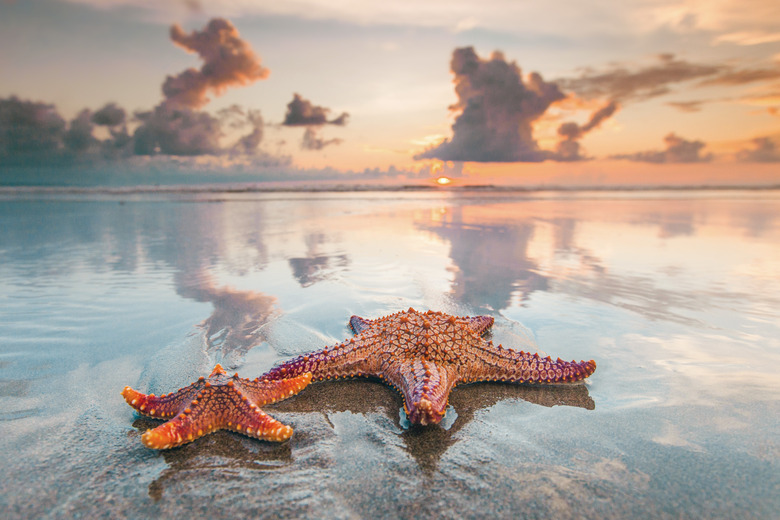When To Get Starfish On The Beach?
What animal has no brain and keeps its eyes on the tips of its legs? If you said 'sea star,' you are correct! Sea stars, or starfish, may be one of nature's wildest creatures. These marine animals are also easy to find, and viewing them is an exciting part of any visit to the beach.
TL;DR (Too Long; Didn't Read)
Sea stars, or starfish, live in all the oceans in the world. You can find them in rocky areas just below sea level like tide pools. The best time to view sea stars is low tide, so consult a local tide table to pick the best time to view sea stars near you. Never harvest live sea stars, and only touch sea stars gently and minimally to avoid injuring them.
All About Sea Stars
All About Sea Stars
People sometimes call sea stars "starfish," but these carnivorous invertebrates aren't actually fish at all. They are echinoderms like sea urchins or sand dollars. While there are approximately 2,000 species of sea stars with a wide variation in their numbers of arms, the most common sea stars all have five legs like a traditional star.
Sea stars are bizarre creatures that lack both brains and blood. They also store their nervous systems and most vital organs in their legs. This allows some sea stars to regenerate after sustaining injuries. One of the most fascinating features of sea stars is the way they consume their prey. They actually send their stomachs outside of their bodies to encompass and digest their meals before returning to their bodies.
Finding Sea Stars
Finding Sea Stars
Since sea stars live in all the oceans on the planet, it is fairly easy to include sea star viewing on your beach trip. These animals only thrive in sea water and generally prefer rocky areas that allow them to cling to rocks just below sea level. Many sea stars are brightly colored, and they tend to live close together.
The ideal time to find sea stars is low tide when tide pools become easy to see. Since the tides vary depending on proximity to the equator, you should check local tide tables to select the best time to look for sea stars near you.
Viewing Sea Stars
Viewing Sea Stars
When you find a sea star, you can very gently touch its body to feel its calcified skin and maybe even encourage it to move while you watch. It is crucial to only touch wild animals like sea stars as little as possible to avoid injuring them. Remember that the regulations that govern harvesting sea creatures vary by location, so removing sea stars from their habitat may be illegal. It is always best to leave wild animals like sea stars in their natural habitats since they are living things and not souvenirs.
If you find a dead sea star and would like to preserve it, you can soak it in a 70% isopropyl alcohol solution for one to two nights, depending on its size. Then, carefully lay the sea star in the sun with its legs down so they do not curl up while drying.
Cite This Article
MLA
Mayer, Melissa. "When To Get Starfish On The Beach?" sciencing.com, https://www.sciencing.com/starfish-beach-8494690/. 17 May 2018.
APA
Mayer, Melissa. (2018, May 17). When To Get Starfish On The Beach?. sciencing.com. Retrieved from https://www.sciencing.com/starfish-beach-8494690/
Chicago
Mayer, Melissa. When To Get Starfish On The Beach? last modified March 24, 2022. https://www.sciencing.com/starfish-beach-8494690/
